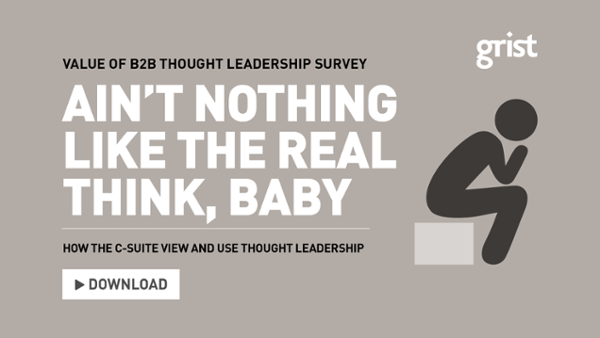The world of information is a little messy right now. Between outright lies from our leaders, ‘fake news’ taking over social platforms and the media spinning dilemmas every which way, it’s difficult to know what’s actually true.
The latest Edelman Trust Barometer shows that less than half of the general population trust the government and the media. That barometer also reveals a sceptical, disillusioned populace that’s looking for reliable sources – 73% of people worry about false information or fake news being used as a weapon.
And that mistrust and anxiety around the information we consume has officially spilled over into the content produced by brands, according to our latest research. Grist asked members of the C-suite around the world about how they view and use thought leadership – the result is our series of Value of B2B thought leadership reports, available here – and found that rhetoric and bluster is now the biggest turn-off you can get.
The fake news effect
When we asked our respondents what turns them off when it comes to the thought leadership they consume, 58% cite ‘unsubstantiated opinions’ – that is, big opinions with little fact to back them up. When you home in on the US, that figure rises to 66%; it’s easy to speculate about the Trump effect here.
This is a global issue, though, and this is a survey we’ve run before. Compare these latest results with those from before the EU referendum in the UK, and ‘unsubstantiated opinions’ has risen from fifth in the list of turn-offs to the top position.
The good news? There is a way to combat this, and its name is data. Our research shows data has increased in importance in the past few years – in 2016, robust data was named a valuable quality in thought leadership by just 29% of respondents; in the most recent survey, data from a reliable source tops the list of sought-after qualities.
Now consider the wider thought leadership landscape, and cast your mind back to the last few white papers or articles you’ve read. How many were thinly veiled sales messages masquerading as research and information? And how many did you actually finish reading and feel you’d learned something new, something that you could use in your day-to-day work life?
It’s not you, it’s me
The problem here is that brands often start thought leadership production with ‘What do we want to say?’ instead of ‘How can we add value to our audience?’ Our data, which comes from an independent survey conducted by research firm Coleman Parkes, shows 68% of senior leaders read thought leadership to gain an edge over competitors, 64% read it to enable them to make better decisions while 66% want to keep informed of emerging trends. Note that none of those reasons is ‘buy something’; they all centre around how to stay on top in the industry and solve challenges.
In fact, thought leadership that is promoting the adviser ‘rather than addressing my problems’ is one of the main concerns senior leaders find with thought leadership; 42% of our respondents list it as a problem with the content they’ve read.
Creating value
In addition to data, also listed as the most valuable qualities in thought leadership are fresh thinking, genuine insight and informed opinion. The C-suite wants to read content that explores issues or challenges from new and different perspectives, and that is not afraid to have an opinion designed to influence thinking – as long as that opinion is backed up by robust, real and reliable data from a trusted source.
It’s essential to remember the target audience when devising any thought leadership. While your goal is to generate leads and, ultimately, convert those leads into clients, thought leadership is different to content marketing. Thought leadership is original, authoritative and insightful content that differentiates your brand and helps your clients, leading to mutually beneficial commercial opportunities. It’s about creating value for both you and your reader, making it work for both sides.
That value should come from well-researched, clearly planned and easily consumed content. It should also help clients to solve their problems; thought leadership that is too conceptual and doesn’t contain any recommendations is third on that turn-offs list, so ensure it is actionable and practical.
Times may be tough for thought leadership but consider this an opportunity for the best marketers to rise to the occasion. Always keep your audience’s needs front of mind and don’t forget to be able to back everything you say with evidence. Only then will you be able to build trust in your thought leadership.
For more insights, download the full report:



